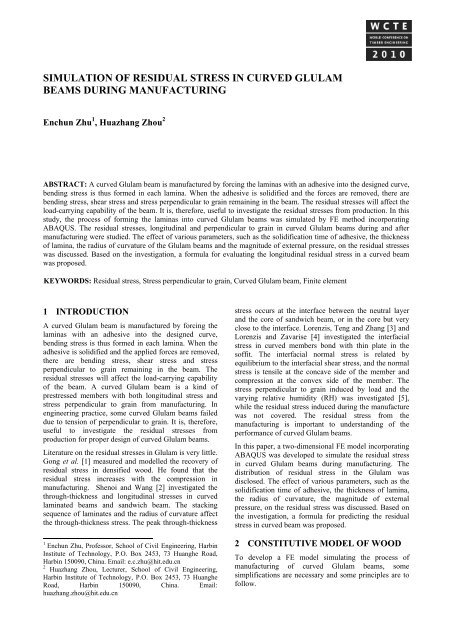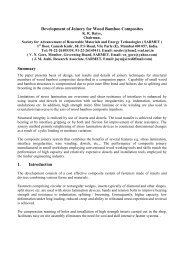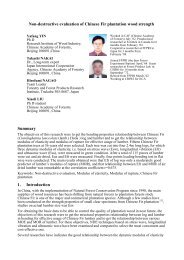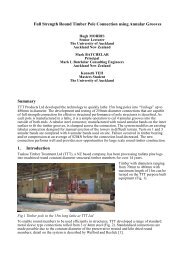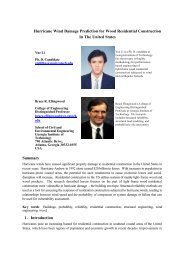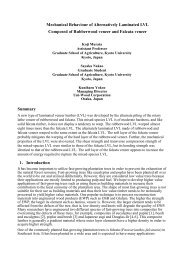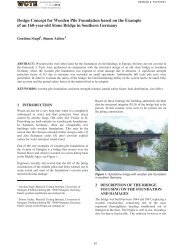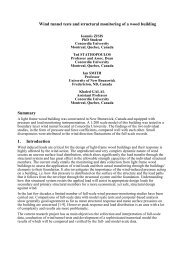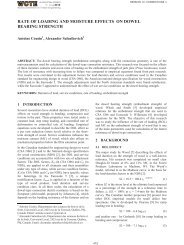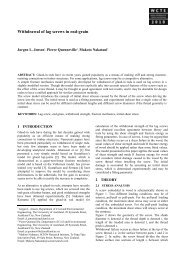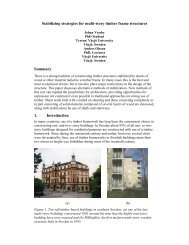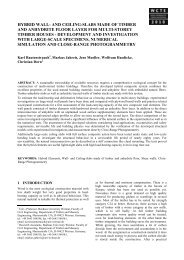simulation of residual stress in curved glulam beams - Engineered ...
simulation of residual stress in curved glulam beams - Engineered ...
simulation of residual stress in curved glulam beams - Engineered ...
Create successful ePaper yourself
Turn your PDF publications into a flip-book with our unique Google optimized e-Paper software.
SIMULATION OF RESIDUAL STRESS IN CURVED GLULAM<br />
BEAMS DURING MANUFACTURING<br />
Enchun Zhu 1 , Huazhang Zhou 2<br />
ABSTRACT: A <strong>curved</strong> Glulam beam is manufactured by forc<strong>in</strong>g the lam<strong>in</strong>as with an adhesive <strong>in</strong>to the designed curve,<br />
bend<strong>in</strong>g <strong>stress</strong> is thus formed <strong>in</strong> each lam<strong>in</strong>a. When the adhesive is solidified and the forces are removed, there are<br />
bend<strong>in</strong>g <strong>stress</strong>, shear <strong>stress</strong> and <strong>stress</strong> perpendicular to gra<strong>in</strong> rema<strong>in</strong><strong>in</strong>g <strong>in</strong> the beam. The <strong>residual</strong> <strong>stress</strong>es will affect the<br />
load-carry<strong>in</strong>g capability <strong>of</strong> the beam. It is, therefore, useful to <strong>in</strong>vestigate the <strong>residual</strong> <strong>stress</strong>es from production. In this<br />
study, the process <strong>of</strong> form<strong>in</strong>g the lam<strong>in</strong>as <strong>in</strong>to <strong>curved</strong> Glulam <strong>beams</strong> was simulated by FE method <strong>in</strong>corporat<strong>in</strong>g<br />
ABAQUS. The <strong>residual</strong> <strong>stress</strong>es, longitud<strong>in</strong>al and perpendicular to gra<strong>in</strong> <strong>in</strong> <strong>curved</strong> Glulam <strong>beams</strong> dur<strong>in</strong>g and after<br />
manufactur<strong>in</strong>g were studied. The effect <strong>of</strong> various parameters, such as the solidification time <strong>of</strong> adhesive, the thickness<br />
<strong>of</strong> lam<strong>in</strong>a, the radius <strong>of</strong> curvature <strong>of</strong> the Glulam <strong>beams</strong> and the magnitude <strong>of</strong> external pressure, on the <strong>residual</strong> <strong>stress</strong>es<br />
was discussed. Based on the <strong>in</strong>vestigation, a formula for evaluat<strong>in</strong>g the longitud<strong>in</strong>al <strong>residual</strong> <strong>stress</strong> <strong>in</strong> a <strong>curved</strong> beam<br />
was proposed.<br />
KEYWORDS: Residual <strong>stress</strong>, Stress perpendicular to gra<strong>in</strong>, Curved Glulam beam, F<strong>in</strong>ite element<br />
1 INTRODUCTION 1iii<br />
A <strong>curved</strong> Glulam beam is manufactured by forc<strong>in</strong>g the<br />
lam<strong>in</strong>as with an adhesive <strong>in</strong>to the designed curve,<br />
bend<strong>in</strong>g <strong>stress</strong> is thus formed <strong>in</strong> each lam<strong>in</strong>a. When the<br />
adhesive is solidified and the applied forces are removed,<br />
there are bend<strong>in</strong>g <strong>stress</strong>, shear <strong>stress</strong> and <strong>stress</strong><br />
perpendicular to gra<strong>in</strong> rema<strong>in</strong><strong>in</strong>g <strong>in</strong> the beam. The<br />
<strong>residual</strong> <strong>stress</strong>es will affect the load-carry<strong>in</strong>g capability<br />
<strong>of</strong> the beam. A <strong>curved</strong> Glulam beam is a k<strong>in</strong>d <strong>of</strong><br />
pre<strong>stress</strong>ed members with both longitud<strong>in</strong>al <strong>stress</strong> and<br />
<strong>stress</strong> perpendicular to gra<strong>in</strong> from manufactur<strong>in</strong>g. In<br />
eng<strong>in</strong>eer<strong>in</strong>g practice, some <strong>curved</strong> Glulam <strong>beams</strong> failed<br />
due to tension <strong>of</strong> perpendicular to gra<strong>in</strong>. It is, therefore,<br />
useful to <strong>in</strong>vestigate the <strong>residual</strong> <strong>stress</strong>es from<br />
production for proper design <strong>of</strong> <strong>curved</strong> Glulam <strong>beams</strong>.<br />
Literature on the <strong>residual</strong> <strong>stress</strong>es <strong>in</strong> Glulam is very little.<br />
Gong et al. [1] measured and modelled the recovery <strong>of</strong><br />
<strong>residual</strong> <strong>stress</strong> <strong>in</strong> densified wood. He found that the<br />
<strong>residual</strong> <strong>stress</strong> <strong>in</strong>creases with the compression <strong>in</strong><br />
manufactur<strong>in</strong>g. Shenoi and Wang [2] <strong>in</strong>vestigated the<br />
through-thickness and longitud<strong>in</strong>al <strong>stress</strong>es <strong>in</strong> <strong>curved</strong><br />
lam<strong>in</strong>ated <strong>beams</strong> and sandwich beam. The stack<strong>in</strong>g<br />
sequence <strong>of</strong> lam<strong>in</strong>ates and the radius <strong>of</strong> curvature affect<br />
the through-thickness <strong>stress</strong>. The peak through-thickness<br />
1 Enchun Zhu, Pr<strong>of</strong>essor, School <strong>of</strong> Civil Eng<strong>in</strong>eer<strong>in</strong>g, Harb<strong>in</strong><br />
Institute <strong>of</strong> Technology, P.O. Box 2453, 73 Huanghe Road,<br />
Harb<strong>in</strong> 150090, Ch<strong>in</strong>a. Email: e.c.zhu@hit.edu.cn<br />
2 Huazhang Zhou, Lecturer, School <strong>of</strong> Civil Eng<strong>in</strong>eer<strong>in</strong>g,<br />
Harb<strong>in</strong> Institute <strong>of</strong> Technology, P.O. Box 2453, 73 Huanghe<br />
Road, Harb<strong>in</strong> 150090, Ch<strong>in</strong>a. Email:<br />
huazhang.zhou@hit.edu.cn<br />
<strong>stress</strong> occurs at the <strong>in</strong>terface between the neutral layer<br />
and the core <strong>of</strong> sandwich beam, or <strong>in</strong> the core but very<br />
close to the <strong>in</strong>terface. Lorenzis, Teng and Zhang [3] and<br />
Lorenzis and Zavarise [4] <strong>in</strong>vestigated the <strong>in</strong>terfacial<br />
<strong>stress</strong> <strong>in</strong> <strong>curved</strong> members bond with th<strong>in</strong> plate <strong>in</strong> the<br />
s<strong>of</strong>fit. The <strong>in</strong>terfacial normal <strong>stress</strong> is related by<br />
equilibrium to the <strong>in</strong>terfacial shear <strong>stress</strong>, and the normal<br />
<strong>stress</strong> is tensile at the concave side <strong>of</strong> the member and<br />
compression at the convex side <strong>of</strong> the member. The<br />
<strong>stress</strong> perpendicular to gra<strong>in</strong> <strong>in</strong>duced by load and the<br />
vary<strong>in</strong>g relative humidity (RH) was <strong>in</strong>vestigated [5],<br />
while the <strong>residual</strong> <strong>stress</strong> <strong>in</strong>duced dur<strong>in</strong>g the manufacture<br />
was not covered. The <strong>residual</strong> <strong>stress</strong> from the<br />
manufactur<strong>in</strong>g is important to understand<strong>in</strong>g <strong>of</strong> the<br />
performance <strong>of</strong> <strong>curved</strong> Glulam <strong>beams</strong>.<br />
In this paper, a two-dimensional FE model <strong>in</strong>corporat<strong>in</strong>g<br />
ABAQUS was developed to simulate the <strong>residual</strong> <strong>stress</strong><br />
<strong>in</strong> <strong>curved</strong> Glulam <strong>beams</strong> dur<strong>in</strong>g manufactur<strong>in</strong>g. The<br />
distribution <strong>of</strong> <strong>residual</strong> <strong>stress</strong> <strong>in</strong> the Glulam was<br />
disclosed. The effect <strong>of</strong> various parameters, such as the<br />
solidification time <strong>of</strong> adhesive, the thickness <strong>of</strong> lam<strong>in</strong>a,<br />
the radius <strong>of</strong> curvature, the magnitude <strong>of</strong> external<br />
pressure, on the <strong>residual</strong> <strong>stress</strong> was discussed. Based on<br />
the <strong>in</strong>vestigation, a formula for predict<strong>in</strong>g the <strong>residual</strong><br />
<strong>stress</strong> <strong>in</strong> <strong>curved</strong> beam was proposed.<br />
2 CONSTITUTIVE MODEL OF WOOD<br />
To develop a FE model simulat<strong>in</strong>g the process <strong>of</strong><br />
manufactur<strong>in</strong>g <strong>of</strong> <strong>curved</strong> Glulam <strong>beams</strong>, some<br />
simplifications are necessary and some pr<strong>in</strong>ciples are to<br />
follow.
The thickness <strong>of</strong> gluel<strong>in</strong>e is neglected due to the fact that<br />
gluel<strong>in</strong>e is only a t<strong>in</strong>y part <strong>of</strong> Glulam, and the typical<br />
thickness is only 0.076-0.152mm [6]. The thickness <strong>of</strong><br />
gluel<strong>in</strong>e is very m<strong>in</strong>or compared with the dimensions <strong>of</strong><br />
Glulam members. Thus, the thickness <strong>of</strong> gluel<strong>in</strong>e is<br />
neglected <strong>in</strong> the FE modell<strong>in</strong>g. But the bond<br />
performance <strong>of</strong> adhesive <strong>in</strong> gluel<strong>in</strong>e is still considered.<br />
The bond performance is different <strong>in</strong> different stages <strong>of</strong><br />
manufactur<strong>in</strong>g. In the stage <strong>of</strong> forc<strong>in</strong>g the lam<strong>in</strong>as <strong>in</strong>to<br />
the <strong>curved</strong> shape, the glue is still a liquid. It has no bond<br />
effect and can also reduce the friction between lam<strong>in</strong>as.<br />
While when the adhesive is solidified, the bond effect is<br />
acquired. Lam<strong>in</strong>as can neither slip relatively nor separate<br />
even when the pressure is removed. The deformation is<br />
so restra<strong>in</strong>ed that a <strong>curved</strong> Glulam beam is completed.<br />
Thus rema<strong>in</strong>s the <strong>residual</strong> <strong>stress</strong>. Because <strong>of</strong> the t<strong>in</strong>y<br />
thickness <strong>of</strong> gluel<strong>in</strong>e, the dimension <strong>of</strong> gluel<strong>in</strong>e is<br />
neglected <strong>in</strong> FE model. The bond performance <strong>of</strong><br />
adhesive is considered through the frictional behaviour<br />
and separat<strong>in</strong>g behaviour <strong>in</strong> FE modell<strong>in</strong>g-when the<br />
adhesive is liquid, the coefficient <strong>of</strong> friction is chosen as<br />
a small value and separat<strong>in</strong>g between lam<strong>in</strong>as is allowed;<br />
when the adhesive is solidified, the coefficient <strong>of</strong> friction<br />
is chosen as a large value (rough friction) and separat<strong>in</strong>g<br />
between lam<strong>in</strong>as is prevented.<br />
The material <strong>of</strong> Glulam is considered as an orthotropic<br />
material. For a two-dimensional problem, the plane<br />
<strong>stress</strong> relationship is<br />
⎡ 1 υ12<br />
⎤<br />
⎢ − 0 ⎥<br />
E1 E1<br />
⎧ε1 ⎫ ⎢ ⎥⎧σ11⎫<br />
⎪ ⎪ ⎢ υ12<br />
1 ⎥⎪<br />
⎪<br />
⎨ε2 ⎬= ⎢− 0 ⎥⎨σ22⎬<br />
(1)<br />
⎪ E1 E2<br />
γ ⎪ ⎢ ⎥⎪<br />
12 τ ⎪<br />
⎩ ⎭ ⎢ 12<br />
1 ⎥⎩<br />
⎭<br />
⎢ 0 0 ⎥<br />
⎢⎣ G12<br />
⎥⎦<br />
where 1 E , 2<br />
wood; 12 G is the modulus <strong>of</strong> shear; υ 12 is Poisson’s ratio;<br />
E are the moduli <strong>of</strong> elasticity (MOE) <strong>of</strong><br />
σ 11 , σ 22 and τ 12 are the <strong>stress</strong> components; ε 11 , ε 22 and<br />
γ are the stra<strong>in</strong> components.<br />
12<br />
3 NUMERICAL SIMULATION OF<br />
STRESSES INDUCED FROM<br />
MANUFACTURING<br />
3.1 MANUFACTURING PROCEDURE<br />
The process <strong>of</strong> manufactur<strong>in</strong>g <strong>curved</strong> Glulam <strong>beams</strong> is<br />
as follows. The lam<strong>in</strong>as sprayed with an adhesive are<br />
pressed on a rigid mould with designed curvature, and<br />
the pressure by apply<strong>in</strong>g external forces is kept until the<br />
designed strength <strong>of</strong> adhesive is reached. Then the<br />
external forces are removed, the <strong>curved</strong> shape can be<br />
reta<strong>in</strong>ed due to the effect <strong>of</strong> bond. The procedure can be<br />
divided <strong>in</strong>to two stages <strong>in</strong> FE modell<strong>in</strong>g. Stage 1, to<br />
press the stacked lam<strong>in</strong>as <strong>in</strong>to the designed curve; Stage<br />
2, to release the pressure after solidification <strong>of</strong> the<br />
adhesive between lam<strong>in</strong>as. In stage 1, the coefficient <strong>of</strong><br />
friction between lam<strong>in</strong>as is reduced by the liquid<br />
adhesive. However, there is still some friction that<br />
depends on the craftsmanship like adhesive apply<strong>in</strong>g<br />
(spray<strong>in</strong>g/brush<strong>in</strong>g) and the type <strong>of</strong> the adhesive.<br />
Because <strong>of</strong> the different solidification times <strong>of</strong> adhesive,<br />
different coefficients <strong>of</strong> friction occurs <strong>in</strong> Stage 1. The<br />
coefficient <strong>of</strong> friction is thus taken as an important factor.<br />
In Stage 2, the <strong>curved</strong> beam is released from pressure<br />
after the adhesive is entirely solidified, and the strength<br />
<strong>of</strong> adhesive reaches such an extent that relative slippage<br />
between lam<strong>in</strong>as is prevented, unless failure <strong>of</strong> gluel<strong>in</strong>e<br />
happens. Therefore, the rough friction between lam<strong>in</strong>as<br />
is considered <strong>in</strong> the Stage 2, i.e. neither relative slippage<br />
nor separation between lam<strong>in</strong>as takes place.<br />
3.2 DETAILS OF THE CURVED BEAMS AND<br />
THE FE MESH<br />
Figure 1 shows a sketch for manufactur<strong>in</strong>g a <strong>curved</strong><br />
Glulam beam, which is made <strong>of</strong> 15 lam<strong>in</strong>as. The crosssection<br />
<strong>of</strong> the <strong>curved</strong> Glulam beam is 90mm×180mm,<br />
and the cross-section <strong>of</strong> each lam<strong>in</strong>a is 90mm×15mm<br />
with a length <strong>of</strong> L=3.2m. The species <strong>of</strong> wood is Ch<strong>in</strong>ese<br />
larch, the density is 580kg/m 3 , the MOE is 12000N/mm 2 ,<br />
the modulus <strong>of</strong> shear is 400 N/mm 2 , the Poisson’s ratio<br />
is 0.42. The designed radius <strong>of</strong> curvature <strong>of</strong> the neutral<br />
axis is 5.0m. Therefore, the radius <strong>of</strong> curvature <strong>of</strong> the<br />
rigid mould is R=4.91m. The magnitude <strong>of</strong> pressure is<br />
p=0.5MPa. Mak<strong>in</strong>g use <strong>of</strong> the symmetry, a half <strong>of</strong> the<br />
beam is modelled <strong>in</strong> the FE analysis. On the symmetrical<br />
face, there is no horizontal displacement and rotation.<br />
Each lam<strong>in</strong>a is meshed with 5mm×5mm CPS4R element<br />
[7]. The coefficient <strong>of</strong> friction between wood is 0.3-0.5<br />
[6]. In Stage 1, the coefficient is set as 0.1 due to the fact<br />
that the liquid adhesive decreases the friction. The rigid<br />
mould is considered as smooth, because the mould is<br />
actually discrete <strong>in</strong> practice. The <strong>residual</strong> <strong>stress</strong><br />
distribution and the rebound<strong>in</strong>g deformation dur<strong>in</strong>g<br />
manufactur<strong>in</strong>g <strong>of</strong> the <strong>curved</strong> Glulam <strong>beams</strong> are<br />
discussed as follows.<br />
Symmetry<br />
R<br />
p<br />
L/2<br />
Rigid mould<br />
Figure 1: Sketch <strong>of</strong> manufactur<strong>in</strong>g a <strong>curved</strong> Glulam<br />
beam<br />
P<br />
h<br />
Figure 2 shows the longitud<strong>in</strong>al <strong>stress</strong> distribution <strong>in</strong> the<br />
mid-length <strong>of</strong> a <strong>curved</strong> Glulam beam after the pressure is<br />
removed. In Stage 1, when the adhesive is liquid, the<br />
lam<strong>in</strong>as can slip relatively. There is no composite action<br />
between lam<strong>in</strong>as. Thus all lam<strong>in</strong>as bend alike. When the<br />
adhesive is solidified, there is no relative slippage<br />
between lam<strong>in</strong>as even when the pressure is removed.<br />
Therefore the entire composite action comes <strong>in</strong>to be<strong>in</strong>g.<br />
In general, the longitud<strong>in</strong>al <strong>residual</strong> <strong>stress</strong> <strong>in</strong> the middle<br />
part <strong>of</strong> beam is larger than that around the free end. The<br />
<strong>stress</strong> <strong>in</strong> the top and the bottom <strong>of</strong> each lam<strong>in</strong>a is the
largest due to the bend<strong>in</strong>g, with a representative value <strong>of</strong><br />
about 13.1MPa for tension at the top and 12.9MPa for<br />
compression at the bottom. Thus, the distribution <strong>of</strong><br />
longitud<strong>in</strong>al <strong>residual</strong> <strong>stress</strong> exhibits a saw-toothed shape.<br />
In the process <strong>of</strong> manufactur<strong>in</strong>g, the largest longitud<strong>in</strong>al<br />
<strong>stress</strong> is about 13.1MPa, which occurs <strong>in</strong> bottom lam<strong>in</strong>a<br />
due to most severe bend<strong>in</strong>g.<br />
Depth (mm)<br />
90<br />
0<br />
-15 0 15<br />
-90<br />
Longitud<strong>in</strong>al <strong>residual</strong><br />
<strong>stress</strong> (MPa)<br />
Figure 2: Longitud<strong>in</strong>al <strong>residual</strong> <strong>stress</strong> distribution at the<br />
mid-length <strong>of</strong> the <strong>curved</strong> Glulam beam<br />
Also <strong>in</strong> Stage 1, when the lam<strong>in</strong>as are bent <strong>in</strong>to a curve,<br />
there is compression between them. The compressive<br />
<strong>stress</strong> perpendicular to gra<strong>in</strong> rema<strong>in</strong>s when the pressure<br />
is removed <strong>in</strong> Stage 2. The <strong>stress</strong> is all compressive<br />
except for where <strong>in</strong> the vic<strong>in</strong>ity <strong>of</strong> gluel<strong>in</strong>e at the end <strong>of</strong><br />
the beam, as <strong>in</strong>dicated <strong>in</strong> Figure 3, which shows the local<br />
distribution <strong>of</strong> <strong>stress</strong> perpendicular to gra<strong>in</strong> at the end <strong>of</strong><br />
the beam. When the glue is hardened and the applied<br />
pressure is removed, the lam<strong>in</strong>as <strong>in</strong> the upper part <strong>of</strong> the<br />
beam tend to rebound and are restra<strong>in</strong>ed by the<br />
neighbour<strong>in</strong>g lam<strong>in</strong>as below, thus giv<strong>in</strong>g rise to tensile<br />
<strong>stress</strong> between lam<strong>in</strong>as at the end <strong>of</strong> the beam. The<br />
largest tensile <strong>stress</strong> perpendicular to gra<strong>in</strong> at the end<br />
cross-section is about 0.16Mpa, while the largest<br />
compressive <strong>stress</strong> perpendicular to gra<strong>in</strong> is 0.085MPa.<br />
In the mid-length the compression is about 0.04MPa.<br />
Figure 3: Residual <strong>stress</strong> perpendicular to gra<strong>in</strong> at the<br />
free end <strong>of</strong> the <strong>curved</strong> Glulam beam<br />
The rebound<strong>in</strong>g <strong>of</strong> a <strong>curved</strong> Glulam beam is also <strong>of</strong><br />
concern. Figure 4 shows the deflection <strong>of</strong> Po<strong>in</strong>t P versus<br />
the pressure applied <strong>in</strong> the process <strong>of</strong> manufactur<strong>in</strong>g.<br />
The maximum deflection, 248.6mm, occurs when the<br />
pressure reaches the maximum. When the pressure is<br />
removed completely, the amount <strong>of</strong> rebound<strong>in</strong>g<br />
deformation is 4.9mmm, leav<strong>in</strong>g a deflection <strong>of</strong><br />
243.7mm rema<strong>in</strong>ed. The rebound<strong>in</strong>g is only 1/635 <strong>of</strong> the<br />
length <strong>of</strong> beam, a very small portion <strong>of</strong> the dimension <strong>of</strong><br />
the <strong>curved</strong> Glulam beam. The rebound<strong>in</strong>g deformation,<br />
which reflects the difference between the designed curve<br />
and the curve <strong>in</strong> manufactur<strong>in</strong>g, is an important factor to<br />
guide the sett<strong>in</strong>g up <strong>of</strong> the mould.<br />
Pressure (MPa)<br />
0.5<br />
0.4<br />
0.3<br />
0.2<br />
0.1<br />
0.0<br />
0 50 100 150 200 250<br />
Deflection <strong>of</strong> po<strong>in</strong>t P (mm)<br />
Figure 4: Rebound<strong>in</strong>g <strong>of</strong> the beam<br />
4 FACTORS AFFECTING THE<br />
RESIDUAL STRESS<br />
The <strong>residual</strong> <strong>stress</strong> <strong>in</strong> a <strong>curved</strong> Gulam beam is affected<br />
by factors such as the magnitude <strong>of</strong> pressure, radius <strong>of</strong><br />
curvature <strong>of</strong> the neutral axis <strong>of</strong> beam, thickness <strong>of</strong><br />
lam<strong>in</strong>a and the time between apply<strong>in</strong>g the adhesive and<br />
apply<strong>in</strong>g the pressure to force the beam <strong>in</strong>to the <strong>curved</strong><br />
shape, as reflected by the coefficient <strong>of</strong> friction <strong>in</strong> Stage<br />
1. The effect <strong>of</strong> these factors will be discussed through<br />
an example <strong>of</strong> simulat<strong>in</strong>g the manufactur<strong>in</strong>g <strong>of</strong> a <strong>curved</strong><br />
Glulam beam with a cross-section <strong>of</strong> 90mm×180mm. In<br />
order to <strong>in</strong>vestigate the effect, some parameters are<br />
prescribed <strong>in</strong> Table 1.<br />
Table 1: Parameters for manufactur<strong>in</strong>g the <strong>curved</strong><br />
Glulam beam<br />
Parameter Unit Value<br />
Radius <strong>of</strong> curvature R m 3.0 4.0 5.0<br />
Pressure p MPa 0.5 0.75 1.0<br />
Thickness <strong>of</strong> lam<strong>in</strong>a t mm 15 20 30 45<br />
Coefficient <strong>of</strong> friction µ 0.05 0.1 0.3 0.5<br />
Figure 5 shows the effect <strong>of</strong> different parameters on the<br />
<strong>residual</strong> <strong>stress</strong> perpendicular to gra<strong>in</strong> <strong>in</strong> the <strong>curved</strong><br />
Glulam <strong>beams</strong>. As a general trend, the <strong>residual</strong> <strong>stress</strong><br />
perpendicular to gra<strong>in</strong> <strong>in</strong>creases with the coefficient <strong>of</strong><br />
friction that <strong>in</strong>creases with the time <strong>in</strong>terval between<br />
adhesive apply<strong>in</strong>g and pressure apply<strong>in</strong>g. This <strong>in</strong>dicates<br />
that the sooner the process <strong>of</strong> Stage 1 <strong>in</strong> the manufacture,<br />
the less the <strong>stress</strong> <strong>in</strong> a <strong>curved</strong> Glulam beam. It can also
e found that larger the pressure and smaller radius <strong>of</strong><br />
curvature <strong>of</strong> the neutral axis give rise larger <strong>residual</strong><br />
<strong>stress</strong> perpendicular to gra<strong>in</strong>. The effect <strong>of</strong> radius <strong>of</strong><br />
curvature is more significant than that <strong>of</strong> pressure on the<br />
<strong>stress</strong> perpendicular to gra<strong>in</strong>. For example, under the<br />
condition <strong>of</strong> µ=0.1, when p=0.5MPa, R=5.0m, the <strong>stress</strong><br />
is 0.16MPa; while when p=0.5MPa, R=4.0m, the <strong>stress</strong><br />
is 0.18MPa and when p=0.75MPa, R=5.0m, <strong>stress</strong> is<br />
0.19MPa.<br />
Residual <strong>stress</strong> perpendicular to gra<strong>in</strong> (MPa)<br />
0.4<br />
0.3<br />
0.2<br />
0.1<br />
p=0.5MPa, R=3.0m<br />
p=1.0MPa, R=3.0m<br />
p=0.75MPa, R=3.0m<br />
p=0.5MPa, R=4.0m<br />
p=0.75MPa, R=4.0m p=1.0MPa, R=4.0m<br />
0.0<br />
p=0.5MPa, R=5.0m<br />
p=1.0MPa, R=5.0m<br />
p=0.75MPa, R=5.0m<br />
0.0 0.1 0.2 0.3 0.4 0.5<br />
Coefficient <strong>of</strong> friction<br />
Figure 5: Residual <strong>stress</strong> perpendicular to gra<strong>in</strong> <strong>of</strong> beam<br />
(cross-section: 90mm×180mm; lam<strong>in</strong>a: 90mm×15mm)<br />
Figure 6 shows the effect <strong>of</strong> different parameters on the<br />
longitud<strong>in</strong>al <strong>residual</strong> <strong>stress</strong> <strong>in</strong> <strong>curved</strong> Glulam <strong>beams</strong>.<br />
Only the radius <strong>of</strong> curvature affects the longitud<strong>in</strong>al<br />
<strong>residual</strong> <strong>stress</strong> <strong>in</strong> a <strong>curved</strong> beam. The smaller the radius<br />
<strong>of</strong> curvature <strong>of</strong> the neutral axis, the more severe the<br />
bend<strong>in</strong>g <strong>of</strong> the lam<strong>in</strong>as and the larger the longitud<strong>in</strong>al<br />
<strong>stress</strong> <strong>in</strong> a lam<strong>in</strong>a. While the coefficient <strong>of</strong> friction and<br />
the pressure pose little effect on the longitud<strong>in</strong>al <strong>stress</strong>.<br />
When radius <strong>of</strong> curvature R=5.0m, the longitud<strong>in</strong>al <strong>stress</strong><br />
is about 13.2MPa; while when R=4.0m and 3.0m, the<br />
<strong>stress</strong> are about 16.5MPa and 22.2MPa, respectively.<br />
Longitud<strong>in</strong>al <strong>residual</strong> <strong>stress</strong> (MPa)<br />
21<br />
18<br />
15<br />
p=0.5MPa, R=3.0m p=0.75MPa, R=3.0m<br />
p=1.0MPa, R=3.0m p=0.5MPa, R=4.0m<br />
p=0.75MPa, R=4.0m p=1.0MPa, R=4.0m<br />
p=0.5MPa, R=5.0m p=0.75MPa, R=5.0m<br />
p=1.0MPa, R=5.0m<br />
12<br />
0.0 0.1 0.2 0.3 0.4 0.5<br />
Coefficient <strong>of</strong> friction<br />
Figure 6: Longitud<strong>in</strong>al <strong>residual</strong> <strong>stress</strong> (cross-section:<br />
90mm×180mm; lam<strong>in</strong>a: 90mm×15mm)<br />
The effect <strong>of</strong> the parameters on the rebound<strong>in</strong>g<br />
deformation <strong>of</strong> <strong>curved</strong> Glulam <strong>beams</strong> is shown <strong>in</strong> Figure<br />
7. Parameters listed <strong>in</strong> Table 1 all affect the rebound<strong>in</strong>g<br />
deformation. The smaller the coefficient <strong>of</strong> friction <strong>in</strong><br />
Stage 1, the more the slippage and the less the composite<br />
action, thus the rebound<strong>in</strong>g deformation is smaller. A<br />
smaller radius <strong>of</strong> curvature and the larger pressure mean<br />
more severe bend<strong>in</strong>g <strong>of</strong> lam<strong>in</strong>a, result<strong>in</strong>g <strong>in</strong> larger<br />
rebound<strong>in</strong>g deformation.<br />
Rebound<strong>in</strong>g deflection (mm)<br />
18<br />
15<br />
12<br />
9<br />
6<br />
3<br />
p=0.5MPa, R=3.0m p=0.75MPa, R=3.0m<br />
p=1.0MPa, R=3.0m p=0.5MPa, R=4.0m<br />
p=0.75MPa, R=4.0m p=1.0MPa, R=4.0m<br />
p=0.5MPa, R=5.0m p=0.75MPa, R=5.0m<br />
p=1.0MPa, R=5.0m<br />
0<br />
0.0 0.1 0.2 0.3 0.4 0.5<br />
Coefficient <strong>of</strong> friction<br />
Figure 7: Rebound<strong>in</strong>g deflection <strong>of</strong> <strong>curved</strong> Glulam beam<br />
(cross-section: 90mm×180mm; lam<strong>in</strong>a: 90mm×15mm)<br />
The effect <strong>of</strong> thickness <strong>of</strong> lam<strong>in</strong>a on the <strong>residual</strong> <strong>stress</strong> <strong>of</strong><br />
<strong>curved</strong> Glulam <strong>beams</strong> is shown <strong>in</strong> Figure 8. Figure 8(a)<br />
shows the <strong>residual</strong> <strong>stress</strong> perpendicular to gra<strong>in</strong> versus<br />
the thickness <strong>of</strong> lam<strong>in</strong>a and Figure 8(b) shows the<br />
longitud<strong>in</strong>al <strong>residual</strong> <strong>stress</strong> versus the thickness <strong>of</strong><br />
lam<strong>in</strong>a. The <strong>residual</strong> <strong>stress</strong> dur<strong>in</strong>g manufactur<strong>in</strong>g is<br />
affected by the thickness <strong>of</strong> lam<strong>in</strong>a. Larger <strong>stress</strong> either<br />
perpendicular to gra<strong>in</strong> or longitud<strong>in</strong>al is formed <strong>in</strong><br />
thicker lam<strong>in</strong>as. It can be found that thick lam<strong>in</strong>as are<br />
actually not suitable for manufactur<strong>in</strong>g <strong>curved</strong> beam due<br />
to the large <strong>residual</strong> <strong>stress</strong> that could exceed the strength<br />
<strong>of</strong> wood.<br />
Residual <strong>stress</strong> perpendicular to gra<strong>in</strong> (MPa)<br />
1.0<br />
0.8<br />
0.6<br />
0.4<br />
0.2<br />
R=5.0m<br />
R=4.0m<br />
R=3.0m<br />
10 20 30 40 50<br />
Thickness <strong>of</strong> lam<strong>in</strong>a (mm)<br />
(a) The effect <strong>of</strong> thickness <strong>of</strong> lam<strong>in</strong>a on the <strong>residual</strong><br />
<strong>stress</strong> perpendicular to gra<strong>in</strong>
Longitud<strong>in</strong>al <strong>residual</strong> <strong>stress</strong> (MPa)<br />
80<br />
60<br />
40<br />
20<br />
R=5.0m<br />
R=4.0m<br />
R=3.0m<br />
0<br />
10 20 30 40 50<br />
Thickness <strong>of</strong> lam<strong>in</strong>a (mm)<br />
(b) The effect <strong>of</strong> thickness <strong>of</strong> lam<strong>in</strong>a on the longitud<strong>in</strong>al<br />
<strong>residual</strong> <strong>stress</strong><br />
Figure 8: The effect <strong>of</strong> thickness <strong>of</strong> lam<strong>in</strong>a on the<br />
<strong>residual</strong> <strong>stress</strong> (p=0.5MPa, µ=0.1)<br />
5 THE FORMULA FOR<br />
LONGITUDINAL RESIDUAL STRESS<br />
For a lam<strong>in</strong>a <strong>in</strong> a <strong>curved</strong> member under pure bend<strong>in</strong>g,<br />
the maximum bend<strong>in</strong>g <strong>stress</strong> is<br />
Et<br />
σ =<br />
h−t 2( R − )<br />
2<br />
(2)<br />
where, E is the MOE <strong>of</strong> the lam<strong>in</strong>a; R is the radius <strong>of</strong><br />
curvature <strong>of</strong> the neutral axis <strong>of</strong> beam; h is the depth <strong>of</strong><br />
beam; t is the thickness <strong>of</strong> lam<strong>in</strong>a.<br />
In a <strong>curved</strong> Glulam beam, the action <strong>of</strong> gluel<strong>in</strong>e, the<br />
normal <strong>stress</strong> and shear <strong>stress</strong>, <strong>in</strong>duce bend<strong>in</strong>g <strong>of</strong> the<br />
lam<strong>in</strong>a, which is different from pure bend<strong>in</strong>g. The<br />
bend<strong>in</strong>g <strong>stress</strong> can be expressed by Eq. (3) by<br />
<strong>in</strong>troduc<strong>in</strong>g an adjustment factor K .<br />
Et<br />
σ max = K<br />
h−t 2( R − )<br />
2<br />
(3)<br />
Through the parametric study, the adjustment factor is<br />
obta<strong>in</strong>ed as K =0.76, by regression <strong>of</strong> the maximum<br />
<strong>residual</strong> longitud<strong>in</strong>al <strong>stress</strong> with different radii <strong>of</strong><br />
curvature and thicknesses <strong>of</strong> lam<strong>in</strong>a. For different<br />
thicknesses <strong>of</strong> lam<strong>in</strong>a commonly used <strong>in</strong> <strong>curved</strong> Glulam<br />
and different radii <strong>of</strong> curvature, the longitud<strong>in</strong>al <strong>residual</strong><br />
<strong>stress</strong> from the FE modell<strong>in</strong>g and Eq. (3) are given <strong>in</strong><br />
Figure 9, which shows good correlation <strong>of</strong> the Equation<br />
and the numerical method. The longitud<strong>in</strong>al <strong>residual</strong><br />
<strong>stress</strong> can thus be evaluated by Eq. (3).<br />
Longitud<strong>in</strong>al <strong>residual</strong> <strong>stress</strong> (MPa)<br />
50<br />
40<br />
30<br />
20<br />
(R=5.0m) FE results Eq.(3) results<br />
(R=4.0m) FE results Eq.(3) results<br />
(R=3.0m) FE results Eq.(3) results<br />
10<br />
10 15 20 25 30 35<br />
Thickness <strong>of</strong> lam<strong>in</strong>a (mm)<br />
Figure 9: The longitud<strong>in</strong>al <strong>residual</strong> <strong>stress</strong> regressed by<br />
Eq. (3)<br />
6 CONCLUSIONS<br />
A two-dimensional FE model was developed to simulate<br />
the <strong>residual</strong> <strong>stress</strong> and rebound<strong>in</strong>g deformation <strong>of</strong> <strong>curved</strong><br />
Glulam <strong>beams</strong> dur<strong>in</strong>g manufacture. The <strong>residual</strong> <strong>stress</strong><br />
perpendicular to gra<strong>in</strong> is generally compressive except<br />
for some tension <strong>in</strong> the lam<strong>in</strong>as around the end <strong>of</strong> <strong>curved</strong><br />
<strong>beams</strong>. Quite significant longitud<strong>in</strong>al <strong>residual</strong> <strong>stress</strong><br />
exists <strong>in</strong> the beam, and the longitud<strong>in</strong>al <strong>residual</strong> <strong>stress</strong> <strong>in</strong><br />
the mid-length is larger than that at the end <strong>of</strong> the length.<br />
Each lam<strong>in</strong>a has the similar <strong>stress</strong> distribution due to<br />
bend<strong>in</strong>g. The longitud<strong>in</strong>al <strong>residual</strong> <strong>stress</strong> can be<br />
evaluated by Eq. (3). The most important <strong>in</strong>fluenc<strong>in</strong>g<br />
factors on the longitud<strong>in</strong>al <strong>residual</strong> <strong>stress</strong> are the radius<br />
<strong>of</strong> curvature <strong>of</strong> the neutral axis and the thickness <strong>of</strong><br />
lam<strong>in</strong>a. As for the <strong>residual</strong> <strong>stress</strong> perpendicular to gra<strong>in</strong><br />
and the rebound<strong>in</strong>g deformation, both are closely related<br />
to the radius <strong>of</strong> curvature, pressure, the time <strong>in</strong>terval<br />
between adhesive apply<strong>in</strong>g and pressure apply<strong>in</strong>g and<br />
the thickness <strong>of</strong> lam<strong>in</strong>a. In manufactur<strong>in</strong>g the <strong>curved</strong><br />
<strong>beams</strong>, smaller pressure, smaller thickness <strong>of</strong> lam<strong>in</strong>a and<br />
quicker manufactur<strong>in</strong>g lead to smaller <strong>residual</strong> <strong>stress</strong>es<br />
and rebound<strong>in</strong>g deformation.<br />
Due to the behaviour <strong>of</strong> creep and relaxation <strong>of</strong> wood<br />
and adhesive, the <strong>residual</strong> <strong>stress</strong> from manufactur<strong>in</strong>g will<br />
decrease. This is worth <strong>in</strong>vestigat<strong>in</strong>g <strong>in</strong> future study.<br />
ACKNOWLEDGEMENTS<br />
The writers acknowledge with gratitude the f<strong>in</strong>ancial<br />
support <strong>of</strong> this study from the National Natural Science<br />
Foundation <strong>of</strong> Ch<strong>in</strong>a designated 50878067.<br />
REFERENCES<br />
[1] M. Gong, L. Li, Y. H. Chui, K. Li and N. Yuan.:<br />
Modell<strong>in</strong>g <strong>of</strong> recovery <strong>of</strong> <strong>residual</strong> <strong>stress</strong> <strong>in</strong> densified<br />
wood. In 10th World Conference on Timber<br />
Eng<strong>in</strong>eer<strong>in</strong>g, 2008.<br />
[2] R. A. Shenoi and W. Wang. Through-thickness<br />
<strong>stress</strong>es <strong>in</strong> <strong>curved</strong> composite lam<strong>in</strong>ates and sandwich<br />
<strong>beams</strong>. Composites Science and Technology,<br />
61:1501-1512, 2001.<br />
[3] L. De Lorenzis, J. G. Teng and L. Zhang. Interfacial<br />
<strong>stress</strong>es <strong>in</strong> <strong>curved</strong> members bonded with a th<strong>in</strong> plate.
Solids and Structures, 43:7501-7517, 2006.<br />
[4] L. De Lorenzis and G. Zavarise. Interfacial <strong>stress</strong><br />
analysis and prediction <strong>of</strong> debond<strong>in</strong>g for a th<strong>in</strong> plate<br />
bonded to a <strong>curved</strong> substrate. International Journal<br />
<strong>of</strong> Non-L<strong>in</strong>ear Mechanics, 44:358-370, 2009.<br />
[5] H. Z. Zhou, E. C. Zhu, S. Fort<strong>in</strong>i and T. Toratti.<br />
Modell<strong>in</strong>g the hygrothermal <strong>stress</strong> <strong>in</strong> <strong>curved</strong> <strong>glulam</strong><br />
<strong>beams</strong>. Journal <strong>of</strong> Stra<strong>in</strong> Analysis for Eng<strong>in</strong>eer<strong>in</strong>g<br />
Design. DOI: 10.1243/0309324JSA563.<br />
[6] Forest Products Laboratory, USDA. Wood Handbook:<br />
Wood as an Eng<strong>in</strong>eer<strong>in</strong>g Material. March 1999.<br />
[7] Abaqus. Version 6.9 Documentation. 2009.


